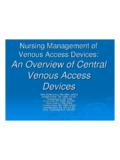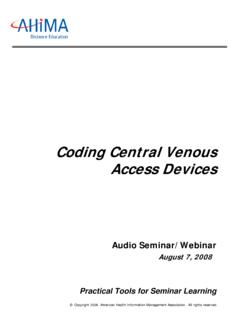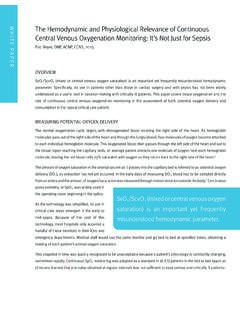Transcription of PERIPHERALLY INSERTED CENTRAL CATHETER …
1 1 PERIPHERALLY INSERTED CENTRAL CATHETER (PICC) Learning Package Return Test to Educator By: Revised June, 2013 2 Table of Content Methods of evaluating competency & Objectives 3 Introduction & Overview of PICC 4 Anatomy & Physiology 6 Indications & Contraindications of PICC 8 Orders & Guideline for Physician notification 9 Nursing Responsibilities 10 PICC Dressings 11 Documentation Overview 13 PICC Flushing Procedural Guideline 16 Needle-less Connector Changes 19 Blood Sampling 21
2 Complications 23 Appendix A: Discontinuation & Removal 26 Appendix B: Managing Occlusion 28 Appendix C: CVAD Care sets 30 References 31 Tip Culture 33 Post Test 34 3 Competency Evaluation & Objectives Competency Evaluation This learning package is one component of the PERIPHERALLY INSERTED CENTRAL CATHETER (PICC) competency. To meet PICC competency, nurses must: 1. Review the self-learning package on Care and Management of PICCs OR Complete the PICC self-learning module on the Learning Management System 2.
3 Successfully achieve 85% or greater on the PICC test 3. Successfully provide a return demo to a Clinical Nurse Educator on each of the following: --dressing change --flushing --changing a needless connector --blood sampling --removal Additional competencies are required for discontinuation/removal and management of an occluded PICC. ONLY nurses who are deemed competent by the Clinical Nurse Educator may discontinue/remove and manage occlusions 4. Successful demonstration on discontinuation and removal 5.
4 Successful demonstration of occlusion management of PICCs OBJECTIVES The following topics will be covered in this learning package: 1. Basic anatomy for PERIPHERALLY INSERTED CENTRAL CATHETER (PICC) 2. Indications & contraindications for a PICC line insertion 3. Possible complications associated with PICC lines 4. Nursing responsibilities for a) care and maintenance b) dressing & needle-less connector changes c) flushing guidelines d) changing needless connector e) obtaining blood samples Additional competencies are required for discontinuation/removal and management of an occluded PICC.
5 ONLY nurses who are deemed competent by the Clinical Nurse Educator may discontinue/remove and manage occlusions 5. Discontinuation/removal of PICC see Appendix A 6. Occlusion management of PICC see Appendix B 4 INTRODUCTION PERIPHERALLY INSERTED CENTRAL Catheters (PICC) are catheters that are PERIPHERALLY placed ( the arm) but they are considered a CENTRAL CATHETER because the CATHETER tip sits in the CENTRAL circulation ( the superior vena cava).
6 CENTRAL catheters are commonly used to provide a reliable infusion route for infusion therapy of all types, however they can put patients at risk for complications from CATHETER related bloodstream infections which can account for significant health care costs and be life threatening. This learning package will empower clinicians caring for patients with these devices with the tools to prevent complications and promote positive outcomes for patients. PERIPHERALLY INSERTED CENTRAL CATHETER PICC lines can differ in size, make & care and maintenance routines.
7 You might encounter different types of catheters when caring for a patient coming from the community or another institution. Therefore, it is important to know what type of PICC your patient has because care and maintenance practices may vary depending on the type. In general, PICC lines are specially formulated 45-60 cm long catheters and made of polyurethane or silicone. It may be a single, double, or triple lumen. The CATHETER could be valved (does not have a clamp) or non-valved (have an external clamp).
8 Valved catheters such as the Power PICC Solo ( INSERTED at NYGH) help prevent the passive entry of blood into the CATHETER . This provides safety for the patient by preventing blood from flowing backwards when the system is open. PICC line catheters are INSERTED through a peripheral vein (basilic, brachial, or cephalic) so that the tip lies in the distal third of the superior vena cava above the right atrium or at the caval-atrial junction. Pressure Activated Valve Consult with your clinical nurse educator and/or the physician for patients who come from another institution or the community with a PICC line that is not familiar to you.
9 The following diagrams are some examples of PICC lines that you might encounter: 5 Power PICC Solo Non-valved ( clamps) Cook PICC line with Non-Valved Technology, single and double lumen. Groshong Non-Valved PICC Line Double Lumen StatLock Securement Device Valved (no clamps ClearClave Needleless Connectors used at NYGH 6 ANATOMY OF THE VEIN WALL The following information is important for understanding the anatomy of the vein and those used for PICC lines.)
10 Tunica Adventitia (Outer Layer) Composed of connective tissue Provides support for the vein and allows the vein to roll Blood vessels in this area provide nutrition to this layer Tunica Media (Middle Layer) Largest layer of the vein, composed of elastic and muscle tissue. Innervated by the SNS (fight or flight response) - promotes venous constriction or dilation in response to anxiety, temperature, mechanical or chemical irritation. Pain can trigger vasoconstriction Tunica intima (Innermost Layer) Composed of one layer of smooth and elastic cells.








